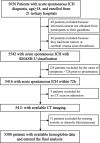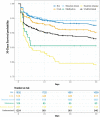Blood Pressure and Outcomes in Patients With Different Etiologies of Intracerebral Hemorrhage: A Multicenter Cohort Study
- PMID: 32924756
- PMCID: PMC7792400
- DOI: 10.1161/JAHA.120.016766
Blood Pressure and Outcomes in Patients With Different Etiologies of Intracerebral Hemorrhage: A Multicenter Cohort Study
Abstract
Background We aimed to investigate the association between blood pressure (BP) and outcomes in intracerebral hemorrhage (ICH) subtypes with different etiologies. Methods and Results A total of 5656 in-hospital patients with spontaneous ICH were included between January 2012 and December 2016 in a prospective multicenter cohort study. Etiological subtypes of ICH were assigned using SMASH-U (structural lesion, medication, amyloid angiopathy, systemic/other disease, hypertension, undetermined) classification. Elevated systolic BP was defined as ≥140 mm Hg. Hypertension was defined as elevated BP for >1 month before the onset of ICH. The primary outcomes were measured as 1-month survival rate and 3-month mortality. A total of 5380 patients with ICH were analyzed, of whom 4052 (75.3%) had elevated systolic BP on admission and 3015 (56.0%) had hypertension. In multinomial analysis of patients who passed away by 3 months, systolic BP on admission was significantly different in cerebral amyloid angiopathy (P<0.001), structural lesion (P<0.001), and undetermined subtypes (P=0.003), compared with the hypertensive angiopathy subtype. Elevated systolic BP was dose-responsively associated with higher 3-month mortality in hypertensive angiopathy (Ptrend=0.013) and undetermined (Ptrend=0.005) subtypes. In cerebral amyloid angiopathy, hypertension history had significant inverse association with 3-month mortality (adjusted odds ratio, 0.37, 95% CI, 0.20-0.65; P<0.001). Similarly, adjusted Cox regression indicated decreased risk of 1-month survival rate in the presence of hypertension in patients with cerebral amyloid angiopathy (adjusted hazard ratio, 0.47; 95% CI, 0.24-0.92; P=0.027). Conclusions This study suggests that the association between BP and ICH outcomes might specifically depend on its subtypes, and cerebral amyloid angiopathy might be pathologically distinctive from the others. Future studies of individualized BP-lowering strategy are needed to validate our findings.
Keywords: 1‐month survival rate; 3‐month death; blood pressure; etiologies; intracerebral hemorrhage.
Conflict of interest statement
None.
Figures




References
-
- van Asch CJ, Luitse MJ, Rinkel GJ, van der Tweel I, Algra A, Klijn CJ. Incidence, case fatality, and functional outcome of intracerebral haemorrhage over time, according to age, sex, and ethnic origin: a systematic review and meta‐analysis. Lancet Neurol. 2010;167–176. - PubMed
-
- Wang Y, Cui L, Ji X, Dong Q, Zeng J, Wang Y, Zhou Y, Zhao X, Wang C, Liu L, et al. The China National Stroke Registry for patients with acute cerebrovascular events: design, rationale, and baseline patient characteristics. Int J Stroke. 2011;355–361. - PubMed
-
- Wei JW, Arima H, Huang Y, Wang JG, Yang Q, Liu Z, Liu M, Lu C, Heeley EL, Anderson CS, et al. Variation in the frequency of intracerebral haemorrhage and ischaemic stroke in China: a national, multicentre, hospital register study. Cerebrovasc Dis. 2010;321–327. - PubMed
-
- Liu M, Wu B, Wang WZ, Lee LM, Zhang SH, Kong LZ. Stroke in China: epidemiology, prevention, and management strategies. Lancet Neurol. 2007;456–464. - PubMed
Publication types
MeSH terms
LinkOut - more resources
Full Text Sources
Medical

